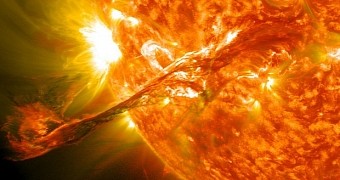Every once in a while, our parent star coughs out massive amounts of gas and magnetized material. Scientists call such events coronal mass ejections.
As cool to observe as they might be, the problem with coronal mass ejections is that, quite often, they birth powerful magnetic storms that can upset our satellites, disrupt radio transmissions and even trigger transformer blowouts and blackouts.
True, not all such solar eruptions and magnetic storms are a threat to our otherwise perfectly calm and peaceful life here on Earth. The thing is that, at least for now, we can only identify those that might cause trouble 30 to 60 minutes in advance.
Hence, we simply don't have enough time to ready ourselves for them and take steps to mitigate their effects on global utility grids and other systems.
Emerging technology could solve this problem
In a report published in yesterday's issue of the science journal Space Weather, Imperial College London researchers explain that the gravity of a coronal mass ejection and the magnetic storm that comes with it depends on the orientation of the magnetic fields birthed by these events.
The scientists go on to describe a novel measurement and modeling tool that they say has the potential to mitigate the impact of solar storms on our life here on Earth by predicting coronal mass ejections at least 24 hours in advance.
The technology detailed by the Imperial College London specialists boils down to guessing where the magnetic fields birthed by solar storms will hit Earth by looking at what shape they take when they form on the Sun and the path they take on their way to our planet.
“Mass ejections originate from two points on the Sun’s surface, forming a croissant-shaped cloud in between that discharges into space. This cloud is full of twisted magnetic fields that shift as they travel,” the scientists explain.
“If one of these magnetic fields meets the Earth’s magnetic field at a certain orientation, the two will connect, ‘opening a door’ that allows material to enter and cause a geomagnetic storm,” they add.
The technology is not quite ready to make its debut
This new model of predicting how coronal mass ejections on the Sun stand to affect utility grids and communications systems here on our planet has until now been tested on a total of 8 such eruptions documented on the surface of our parent star in recent years.
Although the results were encouraging, the team plans to carry out further tests before making the technology available to US' NOAA and the UK's Mett Office. Even so, they expect it will not be long until the model is perfected and predicting solar storms at least 24 hours in advance becomes reality.

 14 DAY TRIAL //
14 DAY TRIAL // 